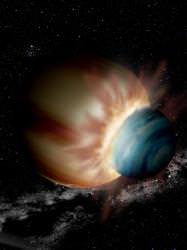Our early Solar System was a violent place. For hundreds of millions of years, large planetoids smashed together, forming larger and larger planets. This same process is happening in other star systems right now. In fact, astronomers have discovered a system where a Neptune-sized object and a Jupiter-sized object might have just smashed together. Ouch.
This newly discovered planet orbits a 25-Jupiter-mass brown dwarf located about 170 light-years away. Computer models show that the brown dwarf is very young, probably only 8 million years old. This means that its planetary companion should be the same age.
And here’s why they think it’s the result of a massive collision. At its current age, the planet should have cooled down to a temperature of about 1000 Kelvin. But recent observations show that it’s actually around 1600 Kelvin. So something heated it up.
That something might have been a planetary collision.
“Most, if not all, planets in our solar system were hit early in their history. A collision created Earth’s moon and knocked Uranus on its side,” explained Eric Mamajek, of the Harvard-Smithsonian Center for Astrophysics. “It’s quite likely that major collisions happen in other young planetary systems.”
An object this size should radiate its heat away over the course of 100,000 years, so this collision must have happened relatively recently.
That’s a pretty exciting possibility, but there are some more conservative possibilities as well. Other astronomers have proposed that the planetary companion is actually much smaller, only the size of Saturn. So it would have a smaller surface area radiating all the detected energy.
If this technique works out, astronomers could just take the temperature of planets in young star systems, and calculate just how long it’s been since they were impacted. “Hot, post-collision planets might be a whole new class of objects we will see with the Giant Magellan Telescope.”
Original Source: CfA News Release


what if this situation goting to happen in21st?